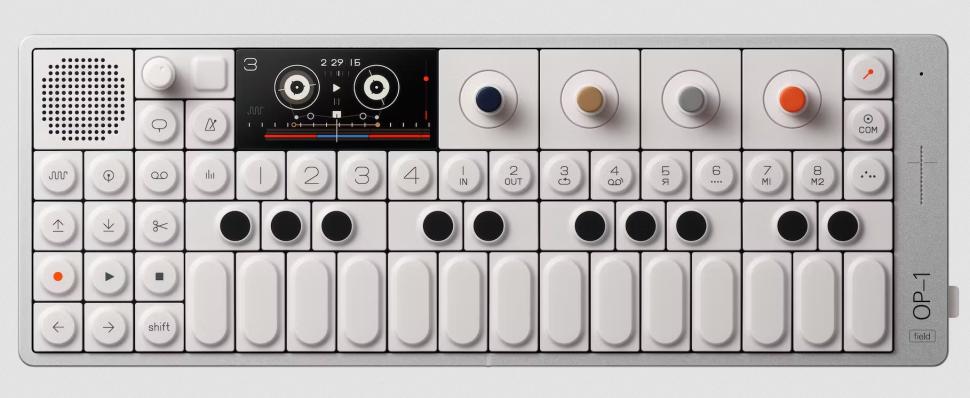Test: The sampler Teenage Engineering OP-1 Field

From the very beginning, Teenage Engineering‘s OP-1 has been the subject of controversy: derided by some as an overpriced hipster toy, loved by others as a creative wonder weapon. And there seem to be quite a few of the latter because, after production was temporarily halted, the ultra-compact synthesizer and recorder became a sought-after item on the second-hand market; and the prices paid there even exceeded the original price, which was already rather high.
The OP-1 Field shows many parallels, as well as clear improvements, compared to the older model. However, the self-confidently set price of 2,000 Euros will once again clearly fuel the above-mentioned discussion.
Even more features
Packing more and more features into small packages is nothing unusual in the electronics sector, but the combination of different synthesizer engines, drums, sampling, digital tape machine, effects, sequencer and even an FM radio in such a small space is still extraordinary and almost unrivaled, especially because the OP-1 is still fast and mostly intuitive to use. The OP-1 Field‘s case is even a bit thinner than the original OP-1‘s, the display is crisper and the brightness is adjustable; and the battery life has been extended by a good third - from 16 to 24 hours.
More sound and memory
There are also improvements in terms of sound. The signal path is now stereo throughout in 32-bit/96kHz, while with the OP-1 you had to make do with 24-bit audio and mostly mono processing. The limitation to a maximum of 6 voices has, unfortunately, remained, but there are more presets (200/300), drumkits (15), synth engines (14), sequencer tracks and effects (8 each). The new dimension synth is flexible with its variable waveforms, and the very good-sounding mother reverb audibly enhances the overall sound. The sample time has also been expanded - from 12 to 20 seconds. The extension of the general recording time is even more drastic; instead of 24 minutes, you now have a whopping 160 minutes of recording time at your disposal! The virtual tape machine still only has four tracks, but there are four different recorder types, including various vintage modes like Tascam Portastudio and Minidisc to choose from.
With the FM Radio, you can now not only listen to stations and sample or otherwise include them in your performance, but Field can also broadcast on an FM frequency. So you basically own your very own radio station!
Optimized speakers
There are also numerous other improvements. For example, the built-in microphone in the Field sounds and responds much better than in its predecessor; however, the optimized speakers are probably even more important for many users. They have been redesigned from the ground up and now offer really wide stereo sound. The speakers in the old model were already above average compared to the speakers in Roland‘s boutique synthesizers or in the Korg Volcas, but Field beats the old OP-1 in terms of sound. If you own an OP-1 and don‘t want to pay the extra price for the new model, don‘t make a listening comparison!
If you play music with headphones or connected speakers anyway, this aspect is, of course, less important. In addition to the above-mentioned detail improvements and enhancements, the Field also scores with another relevant point: optimized operation. Despite the complex possibilities and the small dimensions, this already worked surprisingly well with the OP-1 after a bit of familiarization, which is also due to the color coding and graphic illustrations on the display that only look toy-like at first glance. Fortunately, the basic workflow has not been changed, so that connoisseurs of the OP-1 can also get started immediately with the Field; however, the operation of the Field benefits in particular from the higher resolution display, for instance, when processing samples.
Verdict
The OP-1 Field is a creative wonder weapon; an ultra-portable studio with unique features and stand-alone sound. In addition, there is a robust build and a really well thought-out operation, and the improved display, higher-resolution sound and the more powerful stereo speakers make this little box even more fun. You have to decide for yourself whether this overall package really justifies the currently listed price of 2,000 Euro - despite all the advantages, we consider the price to be too high.
Want more? Get more!



Subscribe to the digital edition of BEAT Magazine via Plugins-Samples.com and get more gear, in-depth workshops, reviews and 11 GB exclusive plugins and new sounds with every monthly issue!
Subscribe to Beat Magazine for only 4.99€ per month
